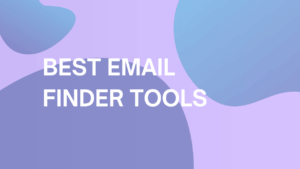
Sales Prospecting: An Easy Guide for Absolute Beginners
If you’re a sales rep or budding sales professional aiming to improve your numbers, understanding the sales prospecting process is crucial.
Welcome to this comprehensive guide where we’ll explore the ins and outs of sales prospecting!
What is Sales Prospecting?
Sales prospecting is the process of reaching out to potential customers (otherwise known as prospects). The aim is to turn these qualified leads into your next big paying customers.
As a sales rep, you’re the boots on the (mostly digital) ground, using tools like cold calling, email blasts, and LinkedIn messages to connect with people who could seriously benefit from your product or service.
These aren’t just random shots in the dark; this is about starting real conversations and figuring out if these leads have what it takes to go the distance in your sales funnel.
Now, don’t underestimate the role of the sales prospecting process! It’s the bedrock of the entire sales cycle.
Nail this down, and you’ll have a stream of prospects ready to convert, helping your business grow and succeed.
Why is Sales Prospecting Important?
Sales prospecting is extremely important in the world of sales for several compelling reasons.
Understanding why this practice is so essential can help you appreciate its value and prioritize it within your sales strategy.
1. Filling the Sales Pipeline
A pipeline without potential customers is like a car without fuel.
You’re not going to get anywhere very fast. Having a consistent stream of qualified email leads is what keeps your sales team in the game, offering them ample opportunities to close those deals.
2. Targeted Engagement
By understanding your ideal customer profile (ICP), you can aim your sales efforts at the people or companies that are most likely to be interested in what you’re offering, saving time and effort.
It’s about doing your homework, researching prospective buyers, and being laser-focused in your approach.
3. Informing Marketing Strategies
The insights gained from prospecting efforts help shape and refine your marketing strategies.
As you engage with potential customers, you gather valuable information about their pain points, needs, and preferences.
The data you gather helps your marketing team create content and campaigns that resonate best with your target audience, increasing conversion rates and improving overall ROI.
4. Shortening Sales Cycles
Prospecting strategies, when executed effectively, can help speed up the sales process.
When you have prospects who are ready to buy or engage with your offerings, you can move them through the sales funnel more quickly.
A shortened sales cycle means smoother and faster deal closures and a more streamlined sales process.
5. Optimizing Resource Allocation
Good prospecting helps you use your resources wisely. Instead of wasting time and effort on unqualified leads, you can focus your energy on prospects who are more likely to convert.
This resource optimization leads to a higher ROI for your sales process.
In essence, sales prospecting is your secret weapon to a winning sales strategy.
It’s what keeps your pipeline flowing with potential customers, allows you to engage with the right leads, and even gives your email marketing campaigns a boost.
Techniques and Strategies for Effective Sales Prospecting
Sales prospecting is an art, a science, and a delicate social dance.
It requires a combination of techniques and strategies to identify and engage potential customers successfully.
Here, we’ll get into the key methods and approaches to elevate your sales prospecting game.
Who Are Your Prospects?
Before diving into the sales prospecting process, sales reps need to define their ideal customer profile (ICP).
Your ICP outlines the characteristics and attributes of the prospects most likely to benefit from your product or service.
Consider factors such as:
- Demographics: What are the age, gender, location, and job titles of your ideal customers?
- Company size: Are you targeting small businesses, mid-sized companies, or large enterprises?
- Industry: Which industries are most relevant to what you’re offering?
- Challenges: What pain points or challenges can your product or service help solve?
- Budget: Do your ideal prospects have the financial capacity to make a purchase?
Creating a detailed ICP helps you narrow your focus and direct your prospecting efforts toward individuals or organizations that align with your offerings.
How to Research Your Prospects
Effective research is the foundation of the most successful sales prospecting strategies.
The more you know about your prospects, the better equipped you are to engage with them in a meaningful way.
Here’s how to conduct thorough prospect research:
- Firmographic data: Gather information about the prospect’s company, including its size, industry, location, and revenue. Tools like ZoomInfo or LinkedIn can provide valuable firmographic data. See below for more details about great sales prospecting tools!
- Technographic data: Understand the technology stack your potential customer uses. This knowledge can help you tailor your pitch based on compatibility with their existing tools or software.
- Sales triggers: Identify events or triggers that create opportunities for engagement, such as recent funding rounds, mergers, or product launches.
- Intent data: Determine the prospect’s level of interest or intent to purchase. Intent data provides insights into the prospect’s online behavior, indicating their readiness to explore solutions like yours.
- Company structure: Understand the internal hierarchy of the prospect’s organization and identify key decision-makers and influencers. This knowledge will help you craft your messaging that resonates with different roles within the company.
How to Contact Your Prospects
Once you’ve identified and thoroughly researched your sales prospects, it’s time to initiate contact.
Effective outreach strategies can make all the difference in capturing the prospect’s attention and moving them further down the sales funnel.
Have a look at these primary methods for contacting prospects:
a) Email Campaigns and Sequences
Email remains a powerful tool for reaching potential customers.
Write well-crafted and personalized emails that resonate with the prospect’s pain points and needs.
If you’re new to the world of email marketing, be sure to check out our cold email follow-up guide!
b) Cold Calling
Contrary to some beliefs, cold calling is still an effective sales prospecting technique.
It allows for direct and real-time communication with sales prospects.
Develop scripts and talking points to be sure that your cold calls are engaging and valuable.
You can also utilize verified mobile number data to increase your connect rate and enrich contact information.
c) Networking Events & Webinars
Participating in or attending industry-specific networking events, conferences, and webinars can be an excellent way to connect with prospects.
These events provide opportunities for meaningful interactions and relationship-building.
Prepare a compelling pitch before you go, bring contact cards, and engage in follow-up activities after the event.
d) Referrals
Using referrals from existing customers or mutual connections can open doors to new prospects.
People are more likely to trust recommendations from someone they know.
Encouraging satisfied customers to refer your product or service to their contacts is a great way to get new leads with little effort on your part.
e) Social Media Prospecting
Utilize social media platforms like LinkedIn to identify and engage with potential customers.
Create a strong social media presence, share valuable content, and reach out to prospects through personalized messages.
Many buyers research vendors on platforms like LinkedIn before engaging with them.
These prospecting techniques are not mutually exclusive.
A combination of approaches customized to your target audience will yield the best results.
Also, remember that effective prospecting involves ongoing refinement and adaptation to resonate more deeply with potential customers.
Sales Prospecting Tools
When it comes to sales prospecting, leveraging the right tools and software can make all the difference.
These tools are designed to enhance your prospecting efforts, making them more efficient and effective.
Below, we’ve highlighted some top sales prospecting tools along with their pros and cons to help you choose the ones that best suit your needs.
1. ZoomInfo
ZoomInfo is your go-to source for comprehensive B2B contact information.
It offers detailed firmographic and technographic data, making it easier for you to identify and research potential customers.
| Pros | Cons |
| Rich database with extensive B2B contacts. | Pricing may be on the higher side for some. |
| Detailed firmographic and technographic data. |
2. Cognism Prospector
Cognism Prospector stands out with its event-based triggers and accurate contact data, improving the efficiency of your prospecting efforts.
| Pros | Cons |
| Event-based triggers for timely outreach. | May require some time to learn and fully utilize its features. |
| Accurate contact data. | |
3. LinkedIn Sales Navigator
If you’re into social media prospecting, LinkedIn Sales Navigator is a powerful tool.
It allows you to discover and connect with potential customers on LinkedIn.
| Pros | Cons |
| Great for social media prospecting on LinkedIn. | It’s more focused on LinkedIn, limiting its scope to one platform. |
| In-depth professional insights. | |
4. HubSpot Sales
HubSpot Sales is an all-in-one solution that offers email tracking, automation, and CRM capabilities.
It streamlines prospecting and lead management.
| Pros | Cons |
| Email tracking and automation. | Full HubSpot suite can be pricey for smaller businesses. |
| Integrated CRM for efficient lead management. | |
These tools are designed to make your sales prospecting efforts more efficient and productive.
Select the ones that align with your specific requirements and are able to integrate into your sales process.
Outbound & Inbound Prospecting
Effective sales prospecting can encompass both outbound and inbound strategies.
Each approach has its unique advantages and can complement others to create a comprehensive prospecting strategy.
Outbound Prospecting
Outbound prospecting involves actively reaching out to potential customers, often through direct outreach methods.
It requires proactive efforts to identify, contact, and engage prospects.
- Cold outreach: Initiating contact with prospects who may have no prior knowledge of your product or service. This can include cold calling, cold emailing, and social media outreach.
- Personalization: Tailoring your messaging and approach to the specific needs and problems of each prospect. Personalized communication is more likely to capture the prospect’s attention.
- Proactive engagement: Taking the initiative to start conversations with potential customers and guiding them through the sales funnel. Outbound prospecting allows you to maintain control over the prospecting process.
Outbound prospecting is effective for reaching a broader audience and generating initial interest.
However, it requires careful planning, research, and a strategic approach.
Inbound Prospecting
Inbound prospecting, on the other hand, involves creating content and establishing a strong online presence to attract potential customers organically.
It focuses on drawing prospects to your brand through valuable and relevant content.
Key components of inbound prospecting include:
- Content marketing: Creating high-quality content that addresses the needs and challenges of your target audience. This content can take the form of blog posts, ebooks, webinars, videos, and much more!
- Search Engine Optimization (SEO): Optimizing your online content and website to rank higher in search engine results. SEO helps prospects discover your brand when searching for relevant topics.
- Social media marketing: Using social media platforms to share content, engage with your audience, and build a community around your brand.
- Lead generation: Capturing leads through forms, gated content, and landing pages. Inbound prospects express their interest by voluntarily providing their contact information.
Inbound prospecting aims to build trust and credibility with potential customers by providing valuable information and solutions.
It relies on the principle that interested prospects will initiate contact with your brand when they are ready to explore further.
A successful prospecting strategy often combines both outbound and inbound approaches to create a balanced and comprehensive approach to reaching potential customers.
Top 5 Tips for Better Sales Prospecting
Effective sales prospecting is a dynamic and evolving process. To help you navigate the challenges and achieve better results, here are five top tips to consider:
- Continuous learning: Stay informed about the latest sales prospecting techniques, tools, and industry trends. Invest in ongoing training and development to sharpen your skills.
- Data quality: Be sure that your prospect data is accurate and up-to-date. Invest in reputable data providers or tools to maintain the quality of your contact information.
- Personalization: Specially tune your messaging to each prospect’s unique profile. Personalized outreach is more likely to hit home and generate responses.
- Follow-up: Persistence is key in sales prospecting. Don’t be discouraged by initial rejections or non-responses. Use effective follow-up strategies to nurture leads over time.
- Feedback loop: Establish a feedback loop between your sales and marketing teams. Regular communication and collaboration can help refine your prospecting strategies and improve alignment.
When you use these tips and continually refine your approach, you can improve or further develop your sales prospecting efforts and drive better results in generating and converting leads.
Conclusion
Sales prospecting is not a one-size-fits-all endeavor.
It requires a deep understanding of your target audience, a well-structured process, and the right tools and techniques.
It doesn’t matter if you’re a seasoned sales professional or just starting your journey, the knowledge and insights provided in this guide can help you sharpen your prospecting skills and achieve remarkable results.
So, go forth with confidence, armed with the knowledge and strategies you’ve gained here, and embark on your sales prospecting journey to uncover new opportunities, forge valuable connections, and drive business growth.
Happy prospecting!



